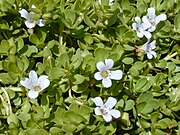Bacopa monnieri
From Wikipedia, the free encyclopedia
| Bacopa monnieri | ||||||||||||||||
|---|---|---|---|---|---|---|---|---|---|---|---|---|---|---|---|---|
 |
||||||||||||||||
| Scientific classification | ||||||||||||||||
|
||||||||||||||||
| Binomial name | ||||||||||||||||
| Bacopa monnieri L. Pennell[1] |
||||||||||||||||
| Synonyms | ||||||||||||||||
|
Bacopa monniera |
Bacopa monnieri (Coastal Waterhyssop, Brahmi, Thyme-leafed gratiola, Water hyssop) is a perennial, creeping herb whose habitat includes wetlands and muddy shores. Brahmi is also the name given to Centella asiatica by some botanists,[2][3] while others consider that to be a mistake that arose during the 16th century, when brahmi was confused with mandukaparni, a name for C. asiatica.[4]
Contents |
[edit] Description
The leaves of this plant are succulent and relatively thick. Leaves are oblanceolate and are arranged oppositely on the stem. The flowers are small and white, with four or five petals. Its ability to grow in water makes it a popular aquarium plant. It can even grow in slightly brackish conditions. Propagation is often achieved through cuttings.
[edit] Ecology
It commonly grows in marshy areas throughout India, Nepal, Sri Lanka, China, Taiwan, and Vietnam, and is also found in Florida and other southern states of the USA where it can be grown in damp conditions by the pond or bog garden.
[edit] Uses
[edit] Medicine
This plant has a number of uses in Ayurveda. It is a traditional treatment for epilepsy and asthma.[5] It has antioxidant properties, reducing oxidation of fats in the bloodstream.[5] Studies in humans show that an extract of the plant has antianxiety effects.[5]
It is listed as a nootropic, a drug that enhances cognitive ability. In India, this plant has also been used traditionally to consecrate newborn babies in the belief that it will open the gateway of intelligence. Laboratory studies on rats indicate that extracts of the plant improve memory capacity and motor learning ability.[5] Recent studies suggest bacopa may improve intellectual activity.[6][7] In a double-blind, placebo-controlled randomized trial, human subjects taking an extract of Bacopa monniera showed significantly improved performance on tests for spatial working memory and rapid visual information processing.[8] The sulfhydryl and polyphenol components of Bacopa monniera extract have also been shown to impact the oxidative stress cascade by scavenging reactive oxygen species, inhibiting lipoxygenase activity and reducing divalent metals.[9] This mechanism of action may explain the effect of Bacopa monniera extract in reducing beta-amyloid deposits in mice with Alzheimer's disease.[9]
[edit] Safety
A standardized Bacopa monniera preparation was evaluated for safety and tolerability in 23 healthy adult volunteers.[10] Participants took 300 mg of the extract daily for 15 days, followed by 450 mg/daily for the subsequent 15 days. No adverse effects were observed in biochemical, electrocardiographic, hematological or clinical parameters in the post-treatment vs. the pre-treatment period. There were some reports of mild gastrointestinal symptoms that resolved spontaneously.
[edit] Kitchen
It is used in Vietnamese cuisine, where it is called rau đắng. It is used in cháo cá, a variety of rice congee made with fish and nấm tràm mushrooms.
[edit] International naming
- நீர்ப்பிரமி (Niirpirami) in Tamil
[edit] See also
[edit] References
- ^ "Bacopa monnieri information from NPGS/GRIN". www.ars-grin.gov. http://www.ars-grin.gov/cgi-bin/npgs/html/taxon.pl?102292. Retrieved on 2008-03-13.
- ^ "In north India, however, brāhmī is commonly identified as Centella asiatica (Linn.) Urban, which in Malayalam is known as muttil. It seems that this identification of brāhmī as C. asiatica has been in use for long in northern India, as Hēmādri's 'Commentary on Aṣṭāṅgahṛdayaṃ (Āyuṛvēdarasāyanaṃ) treats maṇḍūkapaṛṇī (C. asiatica) as a synonym of brahmi." Warrier, P K; V P K Nambiar, C Ramankutty, V.P.K. & Ramankutty, R Vasudevan Nair (1996). Indian Medicinal Plants: A Compendium of 500 Specie. Orient Blackswan. pp. 238. ISBN 9788125003014. http://books.google.com/books?id=GkBRXzpqD98C&pg=PA238.
- ^ Daniel, M. (2005). Medicinal plants: chemistry and properties. Science Publishers. pp. 225. ISBN 9781578083954. http://books.google.com/books?id=5sU6yo1jFxQC&pg=PA225.
- ^ Khare, C. P. (2003). Indian Herbal Remedies: Rational Western Therapy, Ayurvedic, and Other Traditional Usage, Botany. Springer. pp. 89. ISBN 9783540010265. http://books.google.com/books?id=463ERB3VeUoC&pg=PA89.
- ^ a b c d Rajani, M., et al. "Brahmi (Bacopa monnieri (L.) Pennell) - A Medhya Rasaayana Drug of Ayurveda" in Ramawat, K. G., Ed. (2004). Biotechnology of Medicinal Plants: Vitalizer and Therapeutic Enfield, New Hampshire: Science Publishers, Inc.
- ^ C. Stough, J. Lloyd, J. Clarke, L. Downey, C. Hutchison, T. Rodgers, P. Nathan (2001). "The chronic effects of an extract of Bacopa monniera (Brahmi) on cognitive function in healthy human subjects". Psychopharmacology (Berl). http://www.ncbi.nlm.nih.gov/entrez/query.fcgi?db=pubmed&cmd=Retrieve&dopt=Abstract&list_uids=11498727&query_hl=26&itool=pubmed_docsum.
- ^ S. Roodenrys, D. Booth, S. Bulzomi, A. Phipps, C. Micallef, J. Smoker (2002). "Chronic effects of Brahmi (Bacopa monnieri) on human memory". Neuropsychopharmacology (Wollongong) 27: 279. doi:. http://www.ncbi.nlm.nih.gov/entrez/query.fcgi?db=pubmed&cmd=Retrieve&dopt=AbstractPlus&list_uids=12093601&query_hl=1&itool=pubmed_DocSum.
- ^ Stough C, Downey LA, Lloyd J et al. (2008). "Examining the nootropic effects of a special extract of Bacopa Monniera on human cognitive functioning: 90 day double-blind placebo-controlled randomized trial." Phytother Res. 22:1629-1634.
- ^ a b Dhanasekaran M, Tharakan B, Holcomb LA et al. (2007). "Neuroprotective mechanisms of ayurvedic antidementia botanical Bacopa monniera." Phytother Res. 21:965-969.
- ^ Pravina K, Ravindra KR, Goudar KS et al. (2007). Safety evaluation of BacoMind in healthy volunteers: a phase I study." Phytomedicine. 14:301-308.
[edit] External links
| Wikimedia Commons has media related to: Bacopa monnieri |
- Bacopa monnieri List of Chemicals (Dr. Duke's Databases)
- Brahmi (Bacopa monnieri) By Pankaj Oudhia
- Bacopa by Pharmasave. Includes a number of medical references.

